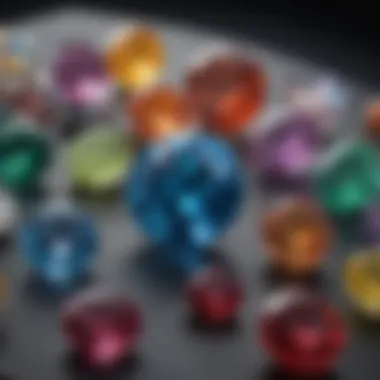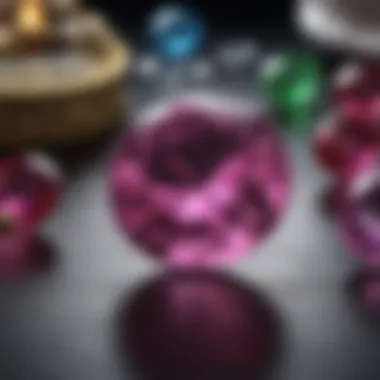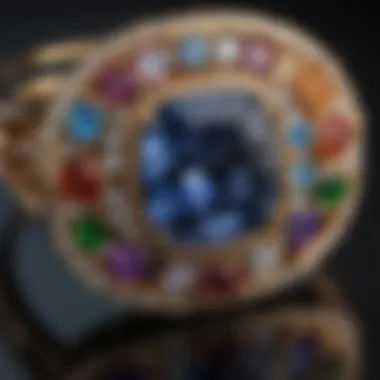Analyzing Birthstone Prices per Carat


Intro
Birthstones have fascinated humankind for millennia, representing more than just a pretty stone. Historically, these gems have held deep personal significance, intertwined with cultural beliefs, traditions, and even religious practices. In today's market, understanding the prices associated with these gemstones can be a puzzle, influenced by various factors such as demand, rarity, and color.
In this analysis, we delve into the intricate world of birthstone prices per carat. We'll uncover the multifaceted characteristics that contribute to their valuation while showcasing how those factors can play a role in your buying decisions. By the end of this exposé, enthusiasts, collectors, and kindred spirits of the gemstone realm will have a well-rounded perspective on the dynamics shaping the market for these lustrous treasures.
Factors Influencing Birthstone Prices
The valuation of birthstones is a nuanced subject, intricately linked to various factors that inform their prices. Understanding these elements is crucial for anyone involved in the purchasing or selling of these beautiful gemstones. Each factor plays a unique role in determining how much one might expect to pay per carat. Buyers, collectors, and gem enthusiasts alike should consider these influences deeply, as they not only affect market valuation but also speak volumes about the gem's history and emotional significance.
Rarity of the Gemstone
Rarity is possibly the foremost consideration in the pricing of birthstones. A gemstone’s scarcity not only elevates its value in the marketplace but also contributes to its allure. For example, stones like Alexandrite and Paraiba Tourmaline are highly prized due to their limited availability. When estimating a birthstone's worth, buyers should look closely at its geological origins and the likelihood of discovering future deposits. If a gem is considered rare, its price per carat is likely to reflect that scarcity, often fetching a premium.
Market Demand and Trends
Market demand plays a critical role in shaping birthstone prices. Fluctuations in fashion trends can lead to sudden spikes in demand for certain gemstones. Consider, for instance, the rising popularity of morganite in recent years. Demand surged as it became a favored choice in engagement rings, impacting its price significantly. Buyers should keep an eye on social media and fashion influencers, as these avenues often impact trends. Really, understanding current market demand can make the difference between a savvy purchase and an overinflated buy.
Quality and Cut of the Stone
Not all gemstones are created equal, and this is where quality and cut come into play. A well-cut stone can enhance the gem’s brilliance and appeal, making it more desirable. For instance, a perfectly cut sapphire will not only look more captivating but will also command a higher price per carat than one that is poorly cut. Make sure to consider the clarity, color, and overall craftsmanship when evaluating a gemstone. These characteristics can drastically change how much you should expect to pay.
Origin and Ethical Sourcing
The origin of a gemstone can significantly affect its value. Gemstones that originate from well-known locations, like Kashmir sapphires, tend to carry a higher price tag. Buyers are becoming increasingly aware of the ethical implications of gemstone sourcing. People today are willing to pay a premium for gems that adhere to ethical and sustainable practices. As a result, stones certified for their origin and ethical mining methods often have a higher market price. Consider asking for provenance and documentation as it can aid in understanding the value of a birthstone.
Seasonal Pricing Dynamics
Seasonal fluctuations influence gemstone prices in various ways. For one, certain months may see heightened interest due to holidays, anniversaries, or other celebrations. Popular occasions for gifting birthstones can drive prices upwards temporarily. Understanding these cycles can help buyers plan their purchases. For example, buying an aquamarine during peak wedding season might push the price higher than during off-peak months. Timing can thus play a pivotal role in savvy gemstone investing.
Being informed about factors influencing gemstone prices can lead to improved buying decisions and awareness of market value. Knowing when to buy and what influences pricing can significantly enhance one’s collection.
Birthstones and Their Cultural Significance
The examination of birthstones goes beyond just their monetary value; it extends into the rich tapestry of human culture and history. These gemstones are not merely pretty trinkets; they hold deep significance for people around the world. Understanding the cultural implications of birthstones helps buyers and collectors alike appreciate them beyond their aesthetic appeal. The belief that birthstones possess unique properties, advantages, or protective qualities has made them an inseparable part of many cultural traditions.


Historical Origins of Birthstones
The history of birthstones can be traced back to biblical times. One of the earliest references comes from the Book of Exodus, where the twelve stones placed on the Breastplate of Aaron were correlated to the twelve tribes of Israel. Each stone symbolized a tribe, and later, these stones became associated with the months of the year. This ancient association laid the groundwork for the modern concept of birthstones. Over the centuries, societies adapted these associations, and birthstones became integral in various cultures, often linked to zodiac signs or celestial bodies.
"Each gemstone whispers tales of eras long gone, revealing connections to cultural identity and heritage."
Cultural Variations in Birthstone Allocations
The concept of birthstones is not universal; different cultures have assigned specific stones to various months, and sometimes the choices differ dramatically from one culture to another. For instance, the modern American list includes gems like garnet for January and emerald for May, while the Ayurveda system in India opts for entirely different selections based on astrological significance. In certain traditions, these gemstones were thought to connect individuals to their birth month—associated with personal characteristics or even fates. Such variations reflect not just differences in culture but signify the local meanings assigned to specific gemstones.
- Western Tradition:
- Eastern Tradition:
- January - Garnet
- February - Amethyst
- March - Aquamarine
- January - Ruby
- February - Blue Sapphire
- March - Moonstone
Spiritual Meanings and Associations
For many, birthstones serve as more than just decorative items; they carry spiritual weight and are believed to possess unique energies that can influence a person's life or emotions. It is said that wearing one's birthstone offers protection, increases confidence, or promotes healing. For example, emerald, known for its vibrant green hue, is associated with rebirth and renewal, making it especially meaningful for those born in May. Similarly, other stones come laden with historical significance; sapphires, often linked to wisdom, were worn by royals throughout history.
In essence, the spiritual meanings attached to birthstones enrich their value beyond market prices. Each gem embodies stories, beliefs, and power that connect individuals to their heritage and personal narratives. Understanding these layers of meaning can help buyers make informed decisions when purchasing or gifting these stones.
Comparative Analysis of Birthstone Prices Per Carat
In distinct realms of gemstone collecting and purchasing, a comparative analysis of birthstone prices per carat serves as a significant cornerstone for both buyers and collectors. Understanding the price differences between various birthstones helps individuals make informed choices, enabling them to align their purchases with both budget constraints and personal preferences. A comprehensive analysis not only reveals the factors influencing prices but also fosters an appreciation for the unique characteristics of each gemstone. It allows potential buyers to consider elements such as quality, rarity, and market trends in their decision-making process.
This section will unfold two critical aspects: the expensive birthstones that command a high price point due to their unique features and market demand, along with more affordable options available for those seeking to treasure the sentiment behind these gems without breaking the bank.
Expensive Birthstones and Their Market Value
Certain birthstones, often coveted for their exceptional beauty and rare qualities, come with a hefty price tag. Understanding what makes these stones stand out can shed light on their valuation in the market. Take the pink diamond, for instance. This rarity can fetch astronomical prices not just due to its coloration but also because of its limited availability. Its shimmering allure speaks volumes, translating into a palpable sense of luxury.
Another notable example is the red beryl, known for its vibrant hue and rarity. While many may look to more common stones like sapphires or amethysts, the exclusivity of red beryl positions it as a gem that collectors chase fervently.
Among notable expensive stones, we can list:


- Painite - Often referred to as one of the rarest minerals on Earth, is prized for its captivating color and crystal structure.
- Alexandrite - This color-changing gem from Brazil is a favorite among connoisseurs.
- Tanzanite - Its stunning blue-violet hue and single geographical source add to its desirability.
When analyzing the market for these stones, demand remains a crucial factor. The rarer the gemstone, particularly one associated with sentimental value, the higher its price. Furthermore, understanding the geological and ethical aspects can also influence buyer choices, adding layers to their investment decisions.
Affordable Options in Birthstone Purchases
While some may focus on the upper echelons of gemstone pricing, many affordable options await to be discovered in the realm of birthstones. Seeking out these gems offers an opportunity for anyone to partake in the beauty and sentimentality associated with birthstones, without anxiously watching the purse strings.
Consider the garnet, often available at a fraction of the cost of its more luxurious counterparts. With its rich red and peachy tones, garnets make for attractive pieces that still carry the weight of being a birthstone. Similarly, amethyst, a popular choice, combines beauty and affordability, allowing enthusiasts to own a stunning stone without feeling the pinch.
Some notable affordable options include:
- Citrine - The cheerful color brightens up any collection and usually fits within a tight budget.
- Peridot - Its vibrant green hue radiates warmth, providing elegant choices for buyers looking for charm without sky-high prices.
- Aquamarine - Known for its serene blue shade, aquamarine is another option that appeals largely while remaining cost-effective.
In the end, a careful examination of birthstone prices per carat unveils a diverse range of options and price points, enabling aficionados to strike a balance between personal taste and financial viability.
"Understanding price fluctuations is key to recognizing the true value behind a birthstone, whether expensive or accessible."
This comparative analysis ultimately empowers the consumer, offering insights that stretch beyond immediate purchases, and encourages a greater appreciation for the full spectrum of choices available.
Investing in Birthstones: A Buyer’s Guide
Investing in birthstones can be a compelling venture for collectors and enthusiasts alike. The charm and vibrancy of these gemstones often go beyond mere aesthetic appeal; they carry layers of meaning, history, and cultural significance. Understanding how to navigate the complexities of this market can not only enhance the beauty of your collection but also provide financial benefits. In this section, we will delve into some critical elements of investing in birthstones, highlighting the benefits and factors to consider.
When you think about investment, it’s not just about putting money into something; it’s about understanding what you’re getting into. Birthstones don't merely symbolize months of the year; they represent personal sentiments, historical narratives, and even spiritual connections for many. As such, the intrinsic value of these stones can fluctuate based on emotional and cultural factors.
Remember: The value of a birthstone may rise or fall based on more than just market trends. It’s intertwined with the emotions and stories of the individuals who cherish them.
Understanding Carat Weight and Its Importance
Carat weight can significantly influence the pricing of birthstones, akin to how the weight of a diamond often does. Each carat is equivalent to 200 milligrams, and with gemstones, larger versions are rarer and usually command higher prices. But it's crucial to remember that weight alone doesn't dictate a stone's worth. The overall quality, including clarity, cut, and color, plays a critical role as well.
For instance, a one-carat sapphire with poor clarity may fetch a lower price than a half-carat stone that is exceptionally clear and well-cut. Here are a few key points to consider regarding carat weight:
- Popularity: Heavier stones often are seen as more desirable among collectors.
- Market Trends: Certain stones may see an increase in value as a larger size becomes trendy.
- Rarity: Larger gemstones are inherently rarer—this can add to their allure and price.


Evaluating Certificate and Appraisal Documents
Before investing, scrutinizing certificates and appraisals is paramount. These documents provide verification of the gemstone's quality and authenticity. It’s essential to look for certificates from reputable labs, such as the Gemological Institute of America (GIA) or the American Gem Society (AGS).
A thorough appraisal should cover important aspects:
- Cut and Quality: An accurate appraisal will provide details about how the stone was cut and its quality.
- Color and Clarity: These factors directly affect both the beauty and value of the stone.
- Market Valuation: A reliable appraisal will include current market value estimates to help guide your decision-making.
Negotiating Prices for Birthstones
Price negotiation is often a delicate dance in the world of gem trading. Open communication is key. If you find a piece that captures your attention but seems steep, here are several strategies to keep in mind:
- Research: Arm yourself with knowledge about market trends and gemstone valuations.
- Be Mindful of Sellers: Different sellers have different markups; know the seller's reputation.
- Point Out Observations: If you notice any imperfections, tactfully mention them—they can often lead to a better price.
- Consider Package Deals: Sometimes, sellers are willing to negotiate if you’re purchasing multiple stones.
By understanding these aspects of investing in birthstones, you can smartly navigate the market and make informed decisions. Keep your eyes peeled for valuable gems, but equally important is appreciating their story—after all, every stone has its unique tale to tell.
Trends Shaping the Future of Birthstone Pricing
The realm of birthstone pricing is constantly evolving, influenced by a myriad of trends that reflect changing consumer preferences, technological advancements, and ethical considerations. Recognizing these trends is crucial for buyers, collectors, and designers who want to stay ahead of the curve in the gemstone market. Understanding how online shopping and sustainability are reshaping the landscape enables consumers to make informed choices and potentially unlock new opportunities in their precious gemstone investments.
Impact of Online Marketplaces
The rise of online marketplaces has fundamentally altered the way birthstones are marketed and sold. Once confined to physical stores, gemstones are now easily accessible through a variety of digital platforms. This movement has some clear implications:
- Wider Access to Inventory: Consumers can browse an extensive range of gemstones from the comfort of their homes. Websites like https://en.wikipedia.org/wiki/Gemstone are useful for research.
- Competitive Pricing: With numerous sellers vying for attention in the digital space, prices can become more competitive. Buyers are able to compare costs across several platforms quickly, enabling them to snag the best deals.
- Transparency in Quality: Many online retailers provide detailed information about the quality and origins of their gemstones. This trend is uplifting for buyers who prioritize certification and ethical sourcing.
While convenience is a significant factor, potential buyers should remain cautious about purchasing through less established websites. It’s essential to verify seller credentials and read reviews thoroughly to avoid falling for scams.
Sustainable Practices in Gemstone Trading
As awareness grows around environmental challenges, sustainable practices in gemstone trading are becoming increasingly relevant. Consumers are now more inclined to support brands that are committed to ethical sourcing and environmentally responsible mining. This not only influences pricing but also establishes a new standard for industry practices.
Key elements of this trend include:
- Ethical Sourcing: Consumers are asking questions about the origins of their gemstones. Stones that can be traced back to responsible mining operations typically command higher prices due to their reduced environmental impact.
- Recycled Gemstones: The concept of using pre-loved stones is gaining traction. Buying recycled gemstones not only helps the environment but can also lead to rare finds that might not be available through conventional channels.
- Brand Transparency: More companies are adopting transparent practices. They openly share their sourcing methods and environmental impacts, which builds consumer trust and can affect price due to higher perceived value.
"Consumers today are more educated and thoughtful about their purchases, which shapes the way businesses operate in the gemstone industry."
This evolving landscape suggests that as sustainability and ethical considerations gain importance among consumers, birthstone prices may adapt to reflect these values.
By staying informed about trends in online marketplaces and sustainable practices, buyers can navigate the current gemstone market more effectively. The future of birthstone pricing will likely be shaped by these dynamics, making it essential for enthusiasts and investors to be aware of these shifts.



